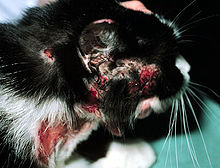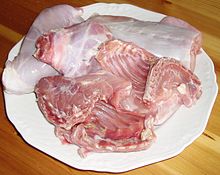User:Nsventzo/sandbox
This article may require copy editing for grammar, style, cohesion, tone, or spelling. (November 2017) |
Not to be confused with Allergies to cats

There are many allergens that cats can be exposed to. These allergies come in many different forms, including flea bite allergies, atopy (inhalant) allergies, and food allergies. Allergies tend to become evident and intensify over extended periods of time, and can take up to years to develop.[1] Symptoms can arise within a few minutes to 1–2 hours after ingestion of the suspected food. These symptoms can include both gastrointestinal and dermatological ones,[2] such as itchy skin, hair loss, and excessive scratching that does not respond to steroid treatments.[3] Atopy usually results in pruritic skin diseases, however signs can be diverse and include miliary dermatitis, symmetrical alopecia, and lesions of the eosinophilic granuloma complex.[3] Food allergies account for approximately 10% of the total allergies in both dogs and cats.[4] Food allergies can be mistaken for food intolerances, which results in vomiting and diarrhea instead of dermal issues.
In most cases, cats will develop allergies to the foods that they eat the most often. There is not a specific breed or age range that food allergies target, however there are certain breeds that are more susceptible to food allergies.[5] For example, Siamese and Siamese crosses may be at increased risk of food allergies versus other breeds.[5]
Common food allergens in cats include beef, dairy, fish, eggs, and chicken. Preservatives and other additives are also occasionally involved in triggering an allergic reaction.[6]
Hypoallergenic elimination diets for cats
[edit]See: Elimination Diet
Limited ingredient diets
[edit]A limited ingredient diet, also known as limited-antigen foods [7] is a type of elimination diet that is devoid of the problematic foodstuff which causes a reaction. Usually these diets are targeted towards the removal of protein (protein-elimination diets) due to dietary allergies usually being caused by water-soluble glycoproteins,[8][9] but can also be targeted towards the removal of gluten/wheat, target vegetables or a combination of both.[8] In commercially available versions of these diets, there is usually one protein and one carbohydrate source, in an effort to minimize reactions to any foodstuffs.[8]
Homemade diets
[edit]See also: Cat Food § Homemade Food
Homemade diets are a type of elimination diet, which is made specifically for the cat with allergies, either by the owner or a third-party person like a chef.[10] Studies suggest that commercial elimination diets may still react negatively with a cat, even if they are devoid of the target protein/other problematic foodstuffs.[10] Many pet owners for this reason choose this option, as well as being able to personally identify the pet's history with various ingredients, and consider the process a bonding experience.[8][10] Some drawbacks to a homemade diet are the time needed opposed to shopping for the ingredients and the potential setback financially.[8]
Homemade diets are generally nutritionally deficient, a study found that 90% of homemade elimination diets are not adequate in terms of nutrition.[8] However, homemade diets are a great way to determine which ingredient is causing the negative symptoms to the cat.[8]
Hydrolyzed proteins
[edit]Hydrolyzed proteins are often used as the primary source of protein in a diet, which is a common technique involved in elimination diets, preventing the effects of allergenic responses.[11] By breaking up the protein into smaller fragments this allows the protein source to bypass the allergenic immune response associated with IgE.[12] This avoidance of the immune reaction allows the animal to eat a sufficient protein source without the immune system interfering.[12]
Novel proteins
[edit]A novel protein is a protein source used in diets for hypoallergenic cats that the cat has not been exposed to before. This depends on what the cat has been fed previously.[13] Common examples of novel proteins are lamb, rabbit, venison, duck, elk, kangaroo, ostrich, emu, goose and goat.[7] However, there is a chance of cross-reactivity. This is when there is a higher taxonomic relationship between the two species so there is a higher chance the cat will react adversely to the novel protein source. Examples of cross reactivity are other ruminant meats if the cat reacted negatively to beef; or avian meats if the cat reacted negatively to chicken.[7]

Novel proteins can be used in elimination diets as well for long term management. Many commercialized novel protein diets are nutritionally adequate and balanced. They have one single protein source and one single carbohydrate source that the cats are unlikely to have seen before.[14] Owners are more likely to be compliant to feeding a commercial novel protein diet as compared to feeding a home cooked diet.[7] This is due to the fact that it can be hard to obtain novel proteins,[14] and it takes less time to prepare.[7] In the early 90s, an experiment was done that showed novel protein diets had a 70% to 80% success rate.[13] However commercialized novel protein diets are not always effective. They are not always tested on animals that have food sensitivities. The processing of the diets can cause adverse reactions due to additives being included which may be allergens to some cats.[13] It is recommended that human-grade meat is used in the diet instead of pet food meats since there can be preservatives which can be detrimental to the cat in pet food meats.[14] There was also a study done which showed that if the processing machinery was not cleaned properly, ground meat that came from one animal could be contaminated with the ground meat from another animal. A study was done which found that four commercial diets using venison had products which were not on the label. Soy, beef and poultry were found in three of the diets which are common antigens in cats. However, if the commercial novel protein diet does not cause an adverse reaction in the cat, it can be used long term.[7]
See also
[edit]References
[edit]- ^ "Feline Food Allergies". www.vet.cornell.edu. Retrieved 2017-11-29.
- ^ E., Guaguere, (1996-11-10). "Food intolerance in cats with cutaneous manifestations: a review of 17 cases". Journal of Veterinary Allergy and Clinical Immunology. 4 (3).
{{cite journal}}: CS1 maint: extra punctuation (link) CS1 maint: multiple names: authors list (link) - ^ a b DACVD, Hilary A. Jackson BVM&S DVD. "Dermatologic manifestations and nutritional management of adverse food reactions". dvm360.com. Retrieved 2017-11-29.
- ^ "Muller & Kirk's Small Animal Dermatology - (Sixth Edition) - ScienceDirect". www.sciencedirect.com. Retrieved 2017-11-29.
- ^ a b Carlotti, Didier N.; Remy, Isabelle; Prost, Christine (1990-06-01). "Food Allergy In Dogs And Cats. A Review and Report of 43 Cases". Veterinary Dermatology. 1 (2): 55–62. doi:10.1111/j.1365-3164.1990.tb00080.x. ISSN 1365-3164.
- ^ Carlotti, Didier N. (2013). Noli, Chiara; Foster, Aiden; Rosenkrantz, Wayne (eds.). Veterinary Allergy. John Wiley & Sons, Ltd. pp. 108–114. doi:10.1002/9781118738818.ch16/summary. ISBN 9781118738818.
- ^ a b c d e f Gaschen, Frédéric P.; Merchant, Sandra R. (2011-03-01). "Adverse Food Reactions in Dogs and Cats". Veterinary Clinics of North America: Small Animal Practice. 41 (2): 361–379. doi:10.1016/j.cvsm.2011.02.005. ISSN 0195-5616.
- ^ a b c d e f g Case, Linda (2010). Canine and Feline Nutrition-E-Book. 3251 Riverport Lane, Maryland Heights, Missouri: Mosby, Inc. p. 400.
{{cite book}}: CS1 maint: location (link) - ^ Leistra, M.; Willemse, T. (December 2002). "Double-blind evaluation of two commercial hypoallergenic diets in cats with adverse food reactions". Journal of Feline Medicine and Surgery. 4 (4): 185–188. doi:10.1053/jfms.2001.0193. ISSN 1098-612X. PMID 12468310.
- ^ a b c Case, Linda (2010). Canine and Feline Nutrition-E-Book. 3251 Riverpool Lane, Maryland Heights, Missouri: Mosby, Inc. p. 399.
{{cite book}}: CS1 maint: location (link) - ^ Zoran, Deb (November 2003). "Nutritional management of gastrointestinal disease". Clinical Techniques in Small Animal Practice. 18 (4): 211–217. doi:10.1016/S1096-2867(03)00074-4. ISSN 1096-2867. PMID 14738201.
- ^ a b "Hydrolysed protein diets (PDF Download Available)". ResearchGate. Retrieved 2017-11-29.
- ^ a b c Verlinden, A.; Hesta, M.; Millet, S.; Janssens, G. P. J. (2006-04-01). "Food Allergy in Dogs and Cats: A Review". Critical Reviews in Food Science and Nutrition. 46 (3): 259–273. doi:10.1080/10408390591001117. ISSN 1040-8398. PMID 16527756.
- ^ a b c Vogelnest, L. J.; Cheng, K. Y. (November 2013). "Cutaneous adverse food reactions in cats: retrospective evaluation of 17 cases in a dermatology referral population (2001-2011)". Australian Veterinary Journal. 91 (11): 443–451. doi:10.1111/avj.12112. ISSN 1751-0813. PMID 24571298.
